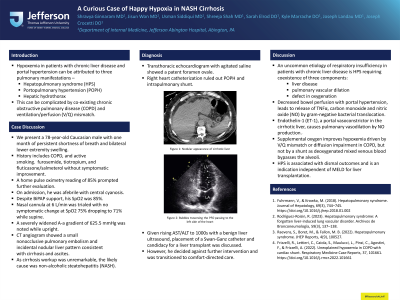Sunday Poster Session
Category: Liver
P1070 - A Curious Case of Happy Hypoxia in NASH Cirrhosis
Sunday, October 22, 2023
3:30 PM - 7:00 PM PT
Location: Exhibit Hall

Has Audio
- SG
Shravya Ginnaram, MD
Jefferson Abington Hospital
Abington, PA
Presenting Author(s)
Shravya Ginnaram, MD, Jisun Won, MD, Usman Siddiqui, MD, Shreeja Shah, MD, Sarah Elrod, DO, Kyle Marrache, DO, Joseph Crocetti, DO, Joseph Landau, MD
Jefferson Abington Hospital, Abington, PA
Introduction: Hypoxemia in patients with chronic liver disease and portal hypertension can be attributed to three pulmonary manifestations - hepatopulmonary syndrome (HPS), portopulmonary hypertension (POPH) and hepatic hydrothorax. This can be complicated by co-existing chronic obstructive pulmonary disease (COPD) and ventilation/perfusion (V/Q) mismatch.
Case Description/Methods: We present a 78-year-old Caucasian male with one month of persistent shortness of breath and bilateral lower extremity swelling. History includes COPD, and active smoking. He was started on furosemide, tiotropium, and fluticasone/salmeterol without symptomatic improvement. A home pulse oximetry reading of 85% prompted further evaluation.
On admission, he was afebrile, with central cyanosis and no platypnea. Despite BiPAP support, his SpO2 was 85%. Nasal cannula at 6 L/min was trialed with no symptomatic change at SpO2 75% dropping to 71% while supine. A severely widened A-a gradient of 625.5 mmHg was noted while upright. CT angiogram showed a small nonocclusive pulmonary embolism and incidental nodular liver pattern consistent with cirrhosis and ascites. As cirrhosis workup was unremarkable, the likely cause was non-alcoholic steatohepatitis (NASH).
Transthoracic echocardiogram with agitated saline showed a patent foramen ovale. A right heart catheterization ruled out POPH and no obvious intracardiac or intrapulmonary shunt. Given rising AST/ALT to 1000s with a benign liver ultrasound, placement of a Swan-Ganz catheter and candidacy for a liver transplant (LT). However, he decided against further intervention and transitioned to comfort-directed care.
Discussion: An uncommon etiology of respiratory insufficiency in patients with chronic liver disease is HPS requiring coexistence of three components: liver disease, pulmonary vascular dilation, and defect in oxygenation.1,2 Decreased bowel perfusion with portal hypertension, leads to release of TNFα, carbon monoxide and nitric oxide (NO) by gram-negative bacterial translocation. Endothelin-1 (ET-1), a portal vasoconstrictor in the cirrhotic liver, causes pulmonary vasodilation by NO production.3 Supplemental oxygen improves hypoxemia driven by V/Q mismatch or diffusion impairment in COPD, but not by a shunt as deoxygenated mixed venous blood bypasses the alveoli. This alludes to underlying diagnosis of HPS, a management conundrum in the acute setting, associated with dismal outcomes and is an indication independent of MELD for LT. 4
Disclosures:
Shravya Ginnaram, MD, Jisun Won, MD, Usman Siddiqui, MD, Shreeja Shah, MD, Sarah Elrod, DO, Kyle Marrache, DO, Joseph Crocetti, DO, Joseph Landau, MD. P1070 - A Curious Case of Happy Hypoxia in NASH Cirrhosis, ACG 2023 Annual Scientific Meeting Abstracts. Vancouver, BC, Canada: American College of Gastroenterology.
Jefferson Abington Hospital, Abington, PA
Introduction: Hypoxemia in patients with chronic liver disease and portal hypertension can be attributed to three pulmonary manifestations - hepatopulmonary syndrome (HPS), portopulmonary hypertension (POPH) and hepatic hydrothorax. This can be complicated by co-existing chronic obstructive pulmonary disease (COPD) and ventilation/perfusion (V/Q) mismatch.
Case Description/Methods: We present a 78-year-old Caucasian male with one month of persistent shortness of breath and bilateral lower extremity swelling. History includes COPD, and active smoking. He was started on furosemide, tiotropium, and fluticasone/salmeterol without symptomatic improvement. A home pulse oximetry reading of 85% prompted further evaluation.
On admission, he was afebrile, with central cyanosis and no platypnea. Despite BiPAP support, his SpO2 was 85%. Nasal cannula at 6 L/min was trialed with no symptomatic change at SpO2 75% dropping to 71% while supine. A severely widened A-a gradient of 625.5 mmHg was noted while upright. CT angiogram showed a small nonocclusive pulmonary embolism and incidental nodular liver pattern consistent with cirrhosis and ascites. As cirrhosis workup was unremarkable, the likely cause was non-alcoholic steatohepatitis (NASH).
Transthoracic echocardiogram with agitated saline showed a patent foramen ovale. A right heart catheterization ruled out POPH and no obvious intracardiac or intrapulmonary shunt. Given rising AST/ALT to 1000s with a benign liver ultrasound, placement of a Swan-Ganz catheter and candidacy for a liver transplant (LT). However, he decided against further intervention and transitioned to comfort-directed care.
Discussion: An uncommon etiology of respiratory insufficiency in patients with chronic liver disease is HPS requiring coexistence of three components: liver disease, pulmonary vascular dilation, and defect in oxygenation.1,2 Decreased bowel perfusion with portal hypertension, leads to release of TNFα, carbon monoxide and nitric oxide (NO) by gram-negative bacterial translocation. Endothelin-1 (ET-1), a portal vasoconstrictor in the cirrhotic liver, causes pulmonary vasodilation by NO production.3 Supplemental oxygen improves hypoxemia driven by V/Q mismatch or diffusion impairment in COPD, but not by a shunt as deoxygenated mixed venous blood bypasses the alveoli. This alludes to underlying diagnosis of HPS, a management conundrum in the acute setting, associated with dismal outcomes and is an indication independent of MELD for LT. 4
Disclosures:
Shravya Ginnaram indicated no relevant financial relationships.
Jisun Won indicated no relevant financial relationships.
Usman Siddiqui indicated no relevant financial relationships.
Shreeja Shah indicated no relevant financial relationships.
Sarah Elrod indicated no relevant financial relationships.
Kyle Marrache indicated no relevant financial relationships.
Joseph Crocetti indicated no relevant financial relationships.
Joseph Landau indicated no relevant financial relationships.
Shravya Ginnaram, MD, Jisun Won, MD, Usman Siddiqui, MD, Shreeja Shah, MD, Sarah Elrod, DO, Kyle Marrache, DO, Joseph Crocetti, DO, Joseph Landau, MD. P1070 - A Curious Case of Happy Hypoxia in NASH Cirrhosis, ACG 2023 Annual Scientific Meeting Abstracts. Vancouver, BC, Canada: American College of Gastroenterology.
